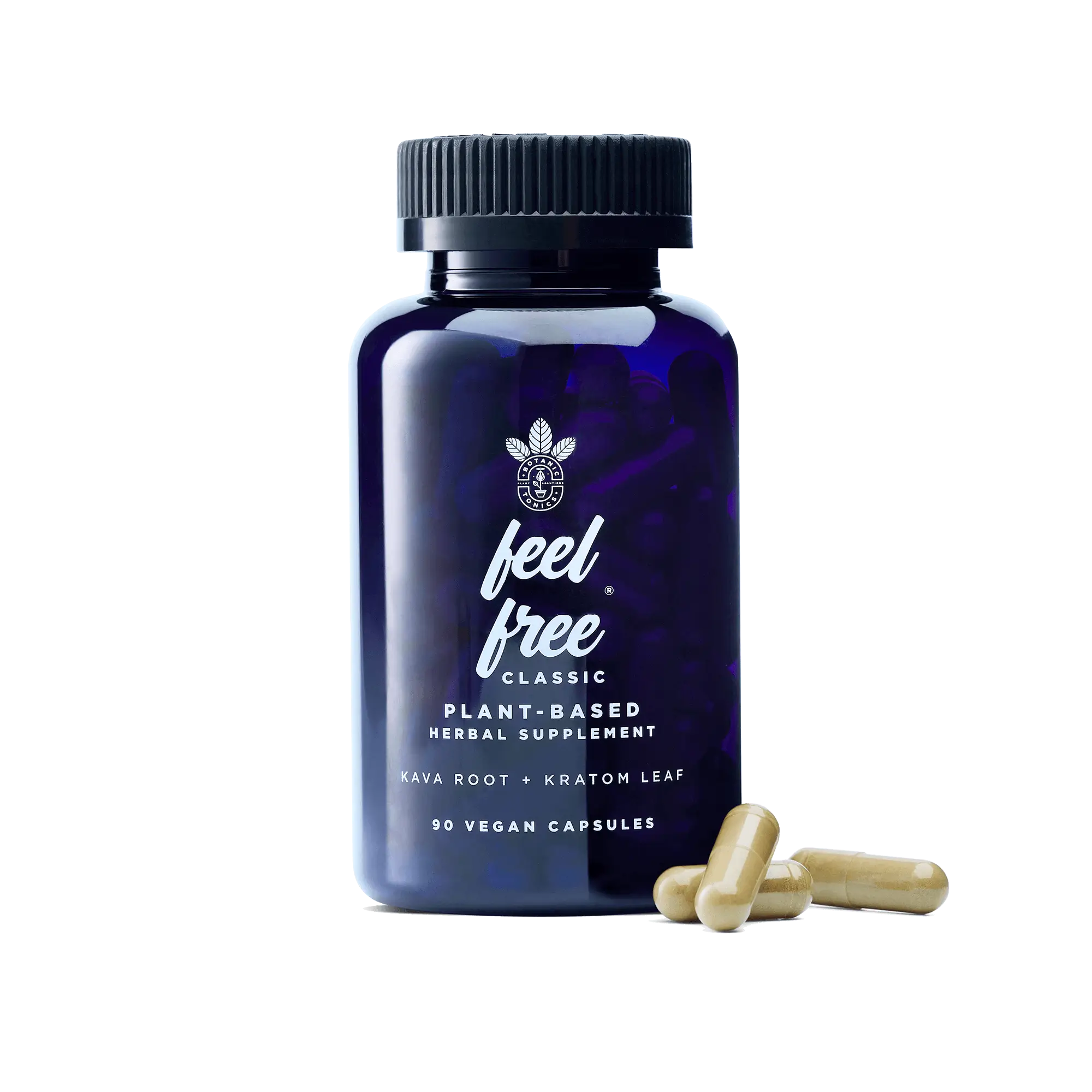The Truth About Smoking Kava: Benefits and Risks Explored
Gone are the days when commercials for Coronas and Camel Lights dominated the screens of our tube TVs. Now, we’re far more likely to see booze-free cocktails laced with adaptogens and the latest vape flavors flashing across the screens of our mobile devices.[1]
Consider kava kava part of this alternative trend. Typically consumed as a tea, mixed tonic, or capsule, Polynesia’s “intoxicating pepper” has become an increasingly popular.[2,3] Following this logic, it seems only natural that kava would now, as it has, emerge as waxes and liquids to slide into your vape.
But is smoking kava advised—let alone safe? And what are the perks of popping kava into your vape pen, pipe, or between rolling papers? Let’s shine some light on the topic.
Understanding Kava

Kava may seem as novel as a concept as functional mushrooms, but just as fungi have been called upon as an herbal remedy for centuries, so has this ancient Polynesian beverage.[4] Derived from Piper methysticum—a perennial shrub native to the South Pacific—kava has long been a keystone in several island nations, including:
- Hawai’i
- Vanuatu
- Micronesia
- Fiji
- Samoa
- Australia
The primary reasons? The ease of mind, brighter mood, and sharpened focus the plant may afford kava enthusiasts—and the sociability that might arrive with it.[6]
What Are Kava’s Traditional Uses?
Traditionally, kava has taken center stage at cultural celebrations and religious rituals where it’s sipped from half coconut shells called bilos in some spots—and, in some cultures, passed out to guests according to one’s rank.[7,8]
In other parts of the South Pacific, kava is chewed (much in the same way you might chew on a piece of Doublemint gum) or chewed and then spit into a bowl that’s used to brew kava tea.
But smoking kava? Now that is a relatively novel concept, as far as we can tell.
The Modern Trend of Smoking Kava
Smokable “herbal blends” have been part of the human fabric for more than 2,500 years, if not longer.[9]
- Native Americans smoked herbs to cleanse their lungs and manage the symptoms of asthma.[10]
- In ancient Ayurvedic medicine, herbs were smoked—in a practice called dhumpana—to alleviate everything from coughs to hiccups.[11,12]
- The first instance of smoking pakalolo (or cannabis) in Hawai’i dates back to 1842, although its usage probably reaches much further back in time[13]
And now? Herbal “joints” are deemed a sage choice for the sober community.[14]
Kava has officially entered this realm of smokable herbs, with more than a handful of companies offering it in blends, e-liquids, and more.
Why Has Smoking Kava Become a Fad?
The potential effects of kava kava are, as we said, usually supplied through a beverage or supplement. Yet, people may choose to smoke kava instead for any or all of these reasons:
Immediacy – Relaxation, a general sense of well-being, enhanced concentration—are just three possible advantages of kava kava. Smoking kava, or smoking anything for that matter, is the fastest path of delivery to your bloodstream (and, therefore, your brain).[15] Translation? You might not have to wait for a kava brew to travel through your digestive tract before you start feeling its impact. Taste – The taste of kava can be…polarizing. Some may love, and even crave, its earthy notes and slightly bitter aftertaste. Others, however, might find it difficult to swallow, even with a chaser like pineapple juice or mixed into an infusion with other fruit juices or coconut milk. So, smoking kava may save some from having to endure its taste (while still reaping its potentially ample rewards).Convenience – Breezing away an afternoon on a stool at a buzzy kava bar might sound like the perfect antidote to a crazy-busy week at work, but we all know that life can get life-y and even our best-laid plans for some R&R can go awry.
While there are a bunch of ways to relish kava from the comfort of your home—such as Botanic Tonics’ kava tonic—you might find smoking kava more convenient, especially if your purist pal insists on one of the traditional preparations of kava, which involves extracting it, grinding it, and soaking it, all before being brewed.
For some people, there’s also the very appeal of smoking, period. It can feel like a ritualized event that may enhance their kava use.
Is Smoking Kava Safe?: The Scientific Perspective and Potential Health Risks
Ultimately, whether smoking kava is safe is up for debate.
There is extremely limited research on the risks of smoking kava; to date, no clinical trials have been conducted on it. (Interestingly, research money is being poured into the possibility of using kava kava as a tool for tobacco smoking cessation.)[16]
However, whether you choose to vape, smoke tobacco-free cigarettes, or participate in a hit or two of a herbal joint, smoking in and of itself isn’t without potential health complications, such as:
Increased risk of metabolic diseases – Studies on the impact of joints made with herbs like damiana and mugwort demonstrate that it may make you more susceptible to chronic metabolic issues, such as diabetes and heart disease.[17]Heightened vulnerability to respiratory problems – Inhaling anything besides air can do a number on your lungs. Research on the effects of vaping, for example, reveals that the “mist” taken in when vaping cloaks your lungs with hazardous particulates.[18] This may lead to a host of health concerns, including the thus-far-incurable “popcorn lung,” which is characterized by coughing, wheezing, and chest pain. Further, the liquid found in vapes may cause lipoid pneumonia and/or primary spontaneous pneumothorax—the scientific term for “collapsed lung.”Escalated lung cancer risk – Individuals searching to curb or eliminate nicotine and tobacco use from their lives might turn to smokable herbs. However, studies indicate that the risk of cancer isn’t exactly lower in those who opt for an herbal cigarette over a regular cigarette.
What’s more, the American Cancer Society points out that tobacco-free herbal smokes are potentially perilous because they emit carbon dioxide, tar, and other chemicals.[19] Lastly, we don’t have enough evidence on what precisely happens to the chemical composition of kavalactones (the active compounds in kava) once kava’s been heated high enough to smoke.
How to Smoke Kava Safely: Tips and Best Practices
Because the risks of smoking kava have yet to be elucidated, we can’t exactly suggest how to smoke it safely. That said, we can (and will happily) advise you on the best rules of thumb to keep in mind when consuming any form of kava extract:
Seek your doctor’s go-ahead – Certain people should steer clear of kava altogether, including pregnant and breastfeeding women, as well as those who have kidney disease, liver damage or disease, depression, and blood disorders.[20] See more on the kava liver damage myth in our guide.
Kava should also be avoided if you take:
- Benzos, such as Valium and Xanax
- Certain medications for Parkinson’s disease and mental health conditions
- Anticonvulsants
- Diuretics
Experiment with caution–and practice moderation – Kava has different effects on different people. Your body size and composition, your age, your tolerance, and the strength of the kava preparation may hit you harder than, say, your partner or best bud.
To this end, stray away from the strongest kava, go slowly and exercise self-restraint: Consuming excessive amounts of kava may trigger dry, scaly skin, malnutrition, and mood swings.[22]
Opt for a quality manufacturer – Kava kava’s popularity has risen dramatically—so much so that it’s expected to become a 3.41 billion market by 2029.[23] As with anything that’s become marketable, snake oil salesmen are a real problem (just think of faux CBD companies).
With this in mind, it’s more important than ever to purchase kava from a reputable manufacturer who’s transparent about where their kava comes from (it ought to have been harvested in the South Pacific) and guarantees that their products undergo stringent third-party testing.
Trust feel free for All Your Kava Needs

Smoking kava is a relatively new trend, so its effects haven’t been studied thoroughly. Our advice? Listen to your elders and partake in kava as it has been consumed for centuries: through a tonic or, as we’ve seen more recently, a capsule or supplement.
Besides, with a smorgasbord of top-shelf kava products to choose from, experiencing the benefits of kava has never been easier (or more safe).
Looking to introduce kava to your life? Botanic Tonics has the buffet of kava treats you’ve been searching for. Our feel free CLASSIC tonic is made with kara root and leaf kratom. Feel kava at its finest with Botanic Tonics—no lighter required.
Sources:
- The Washington Post. ‘Adaptogenic’ drinks advertise a booze-free good time. Read this before imbibing. https://www.washingtonpost.com/wellness/2022/01/13/adaptogen-drinks-alcohol-replacement/
- Drug Enforcement Administration. Kava. https://www.deadiversion.usdoj.gov/drug_chem_info/kava.pdf
- Healthline. Kava kava: benefits, side effects and dosage. https://www.healthline.com/nutrition/kava-kava#TOC_TITLE_HDR_5
- Live Science. What are medicinal mushrooms? https://www.livescience.com/what-are-medicinal-mushrooms
- The New York Times. Stressed New Yorkers take to kava, ‘nature’s Xanax.’ https://www.nytimes.com/2017/12/21/nyregion/stressed-new-yorkers-take-to-kava-natures-xanax.html
- Mount Sinai. Kava kava. https://www.mountsinai.org/health-library/herb/kava-kava
- Research Outreach. Traditional kava-drinking, cognition, and driver fitness. https://researchoutreach.org/articles/traditional-kava-drinking-cognition-driver-fitness/
- Hawai’i Journal of Health and Social Welfare. The current use of sakau (kava) in Pohnpei Island, Federated States of Micronesia. https://www.ncbi.nlm.nih.gov/pmc/articles/PMC9272527/#:
- National Geographic. Earliest evidence for cannabis smoking discovered in ancient tombs. https://www.nationalgeographic.com/culture/article/earliest-evidence-cannabis-marijuana-smoking-china-tombs
- Mount Sinai. Lobelia. https://www.mountsinai.org/health-library/herb/lobelia
- Molecules. Validation of broth macrodilution volatilization method for testing of essential oils in liquid and vapor phase: chemical composition, cytotoxicity, and antibacterial effect of Indian medicinal plants against pneumonia-causing pathogens. https://www.ncbi.nlm.nih.gov/pmc/articles/PMC10304056/
- Practo. Benefits of Ayurvedic herbal smoking. https://www.practo.com/healthfeed/benefits-of-ayurvedic-herbal-smoking-37029/post#
- Honolulu Civil Beat. Pakalolo’s long history, regulated future in Hawaii. https://www.civilbeat.org/2016/02/pakalolos-long-history-regulated-future-in-hawaii/
- The Independent Florida Alligator. Sobriety movement aided by alternative herbal joints, mocktails. https://www.alligator.org/article/2023/02/sobriety-shift
- Learn. Genetics. Drug delivery methods. https://learn.genetics.utah.edu/content/addiction/delivery
- University of Florida Health. UF team receives grant to study kava as smoking cessation aid. https://cancer.ufl.edu/2023/08/22/uf-team-receives-grant-to-study-kava-as-smoking-cessation-aid/
- ACS Omega. How do herbal cigarettes compare to tobacco? A comprehensive review of their sensory characters, phytochemicals, and functional properties. https://www.ncbi.nlm.nih.gov/pmc/articles/PMC9773184/
- Johns Hopkins Medicine. What does vaping do to your lungs? https://www.hopkinsmedicine.org/health/wellness-and-prevention/what-does-vaping-do-to-your-lungs
- American Cancer Society. Is any type of tobacco product safe? https://www.cancer.org/cancer/risk-prevention/tobacco/is-any-type-of-smoking-safe.html
- Cleveland Clinic. When it comes to kava, ‘natural’ doesn’t mean safe. https://health.clevelandclinic.org/what-is-kava/
- Alcohol and Drug Foundation. Kava. https://adf.org.au/drug-facts/kava/
- Outrigger. Culture: sampling Fiji’s most famous drink. https://www.outrigger.com/stories/2021/january/fiji-kava
- Fortune Business Insights. Kava root extract market size. https://www.fortunebusinessinsights.com/kava-root-extract-market-103694
















